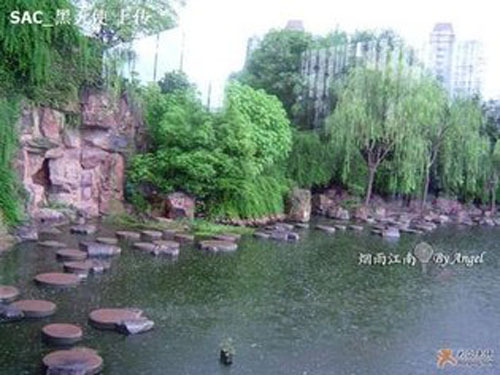
According to Shen Taizhao's "Spring Harvest Collection", "Shichahai, the west gate of Di'anmen, the lotus is the most prosperous, and during the month of June, women and men gathered, all on the northern shore of the Qianhai. The tea shed was set up between Tongzhi and Tim was used for various things." The “North Shore of the Qianhai†was also the Tongzhi and Guangxu years of the Qing Dynasty. Afterwards, a restaurant was built by taking a tea shed. Many houses were built in succession, and the location was about the current Yinyinqiao side barbecue season rice restaurant, and the lotus market. Move to the embankment in the middle of the Qianhai. At that time, the sea of ​​Shicha was planted in lotus trees and the banks of the river were weeping by rivers. The scenery was excellent. The market was named after the lotus market. At the end of the Qing dynasty, "Scorpio EVENINGS" described its situation as: "Everyone is on the move, mostly set in Shichahai, and the city has recently gone to the city. Therefore, the skirts clamor for competition. Long summer sunset, the beginning of the fire umbrella. Liuyin melody, Fans in front of the fan, a few seats, tea and melons. Glass ten hectares, lysed in a roll, smashing a stick, and fragrance." Depicted as a mellow and imaginative gouache.
At the time of the late Qing Dynasty and early Republic of China, the Lotus Market was a seasonal market, which was opened approximately every year after the Dragon Boat Festival in May. After the Blue House meeting in July, it was time to close with the cooler weather. Seriously, the most lively year of the year is always in June and July. It can be said that it is a collection of department stores. The items sold include daily necessities, antique calligraphy, arts and crafts, and all Beijing-style snacks. In addition, the city's lotus blossoms, water chestnuts, and tender oysters are suitable for all kinds of people's needs. Nature is very popular. The performances include a variety of dramas, operas, juggling, storytelling, singing drums, and Latin American films. They are all available in a variety of ways. They can appeal to both young and old, so they can attract a wide variety of people from their official residences. Scholars and literary people, to the common people, flat people, are happy, linger forget, the scene is almost more than the first month to visit the factory dian even more lively. The Beijing Folk Songs edited by the popular Beijing dialect called “The 12 Scenes of Beijing Folklore†sang specifically: “The June 3-4 volt is a hot day, and Shichahai is just enjoying the lotus. The male and female women are constantly listening to the drum book and listening After visiting the riverside, the fruit stands full, the watermelon melons are sweet, the iced sour plum soup hits the ice, and the handles are bought and the home is turned."
After entering the market, the lotus market continued to flourish for a while. The "Old Cultural Relics" published in 1933 also stated: "In the past three weeks before the sea, the lotus is extremely prosperous. Most of the northwest sides are the first house. There are long embankments in the middle, from the north to the east, along the embankment, the willows will rise into the clouds. From summer to autumn, there are tea gongs on the embankment and hundreds of operas are played for entertainment.†However, with the move of the Kuomintang government to Nanjing, the lotus market has gradually declined and it has finally become invisible. In the late 1930s, performances gradually faded.
It was not until 1990 that Beijing rebuilt and opened the lotus market. The well-known calligrapher Mr. Qi Gong wrote the name of the “Lotus Market†and hung it on the archway of Qianhai West Street. At that time, the market opened a variety of flavors and food stalls, frying and cooking, open-air production, get smoking at the office, causing very serious pollution. In order to protect the environment around Shichahai, the relevant departments completely withdrew the food stalls, and once changed the lotus market to the antique market. In 2001, the Lotus Market was reconstructed into an antique building connected to the first floor and the second floor. On the side of the water, a wooden trestle with a width of about 4 meters was built to form a simple pedestrian mall. In 2004, it was named by the Beijing Municipal Bureau of Commerce as Shichahai. Tea Bar features commercial street.
Stainless Steel Cutting Board Rack
Cutting Board Rack,Cutting Board steel rack,Cutting Board Organizer rack,Stainless Steel Cutting Board Rack,Chopping Board Rack,Stainless Steel Chopping Board Rack, The materials are used 304 stainless steel, easy to clean, never rust!
Kichen Rack is made of high quality 304 stainless steel, This kind of material steel luxury, never rust, resist corruption, easily clean, safe, healthy and durable. Prevent rust or chemicals from contaminating food and damaging health
Cutting Board Storage Rack,Cutting Board Holder,Stainless Steel Cutting Board Rack,Chopping Board Rack
Shenzhen Lanejoy Technology Co.,LTD , https://www.baking-rack.com